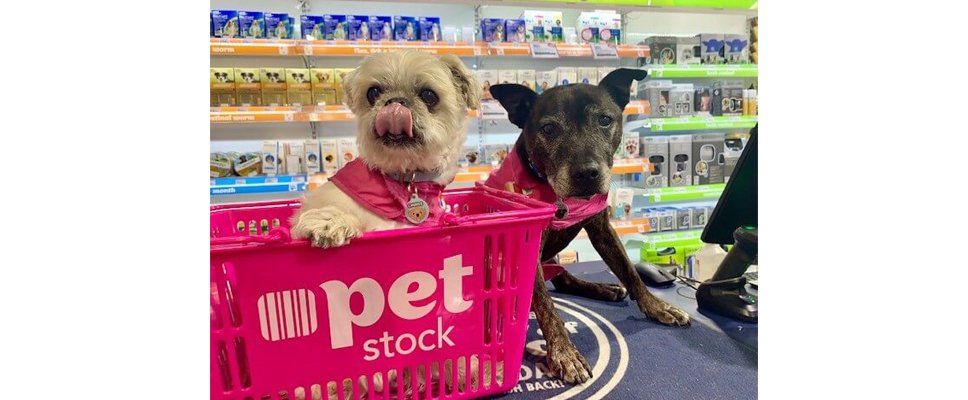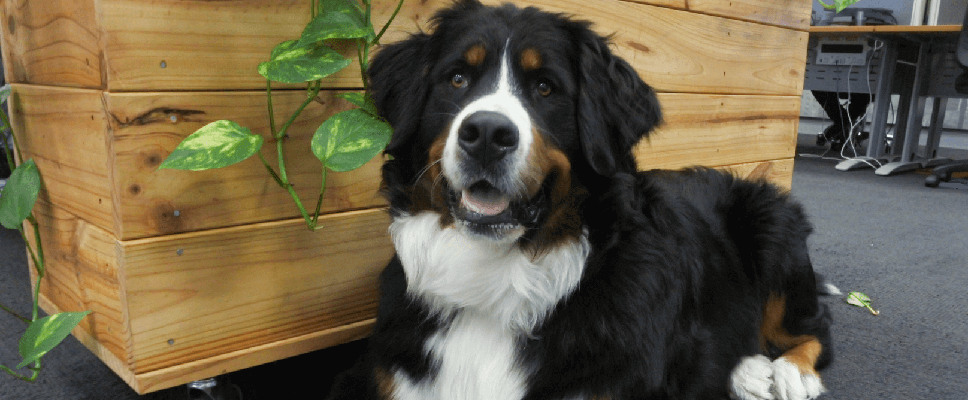Dog friendly workplaces and the benefits
PETstock • August 29, 2022


Australia, the search is on.
For its 2nd consecutive year, people2people, along with our headline sponsor
PETstock, and new sponsor
DRONTAL, is proud to celebrate 2022 #OZTOPDOG.
Enter your four-legged best friend into our 3 prestigious awards categories: OZ Top Dog with a Job, OZ Top Office Dog, and OZ Top Home Office Dog (people's choice). Entries are open 29th August 2022 - 18th September 2022.
Get your dog in, enter now.
Dogs at work? For many, it is the dream. Luckily, it has become a lot more common in Australia, and internationally. Gone are the days that we consider dogs to be a disruption to our work routines. In fact, dogs can make work better.
PETstock is one of many dog friendly workplaces in Australia all year round, and it’s truly a game changer.
We want to remind everyone just how beneficial this can be, not only to spark a bit (or a LOT) of joy in each day, but also the benefits for dogs, customers and clients.
Dogs help boost employee morale and wellbeing
It’s no surprise, and widely accepted, that dogs, and pets in general, help boost your mood and reduce stress. Dogs do so much for our mental and physical health, that it makes sense they can do this for more than just their owner. In a sometimes, fast-paced, high stress environment, the power of dogs is heightened. Just patting a dog can calm an anxious worker, and therefore employers/and businesses now have trained therapy dogs entering workplaces on a regular basis. In especially high-stress workplaces, such as emergency call centres and emergency service offices, therapy dogs visit many times a week to lend a paw to those struggling, or those who just need a little extra support to get through the week. There are also therapy dogs who are not formally trained, but still assist humans in need, in a similar manner. Each of these dogs, deserve many medals.

Meet Addis-Bell – A dog that brings a smile, cuddle and comfort every day
At Ambulance Victoria, you can imagine the work is highly rewarding but also, at times, quite challenging. What can really lift the mood is a dog. Jacqui, who works as a Graduate Progression Coordinator, often brings her beautiful Newfoundland, Addis-Bell (AB), into the office. She brings joy to not only Jacqui's day but also colleagues and graduates.
"Assessment day for graduates can be a time of high anxiety and stress, so AB will often come in on those days to act as a source of comfort for those undertaking exams and assessments. You can really feel the change of atmosphere in the room when she's around, she just makes everyone feel so relaxed. In-between assessments, some of the graduates will sit with her, pat her and talk to her for comfort," says Jacqui.
And it is not just Ambulance Victoria that Addis-Bell visits. On the days she isn't at work with Jacqui, she's on the worksite as a tradie dog with Jacqui's husband. High vis vest and all.
"I think everyone should be able to bring their dog to work! That's the dream, right? Of course, it is essential that your dog is relaxed and happy to be there. For AB, she's comfortable curling up next to my desk when she's not interacting with anyone else or being a practice patient for the graduates."
Dogs can be a highlight for your customers or clients
If you have a dog friendly workplace, it not only makes the workplace more joyful and relaxed for team members, but also, a whole lot more interesting for guests. Without a doubt, animal lovers and specifically dog lovers can’t deny how a chance meeting with a friendly dog can change their day. Plus, it also makes for a great start way to engage with customers or clients.

Meet Chubbs and Angel – A-list influencers bringing their A-game
Chubbs and Angel love coming into work with their owner Teisha, which happens to be at PETstock Artarmon, New South Wales. These two have been permanent fixtures at the store for a stellar nine years, and love interacting with new friends on the daily. They’re also so well behaved, that they know all the store treats are off-limits – until provided one of course.
“They love greeting customers much more than being at home all day. Meeting all the people and pets who walk through our doors is great for their mental stimulation and socialisation. You see the smiles on customers’ faces when the dogs are in-store to greet them; they know them by name, and you can see their disappointment on the days I do not bring them with me. My dogs are my world, and I am grateful that I can spend as much time with them as possible on a day to day basis.” – Teisha, PETstock Artarmon
It offers enrichment for your dog
While we all love the idea of dogs bringing us joy and emotional therapy, bringing dogs or pets to work can also offer them a unique and great opportunity for enrichment. When you bring a dog into a new environment, especially from a young age, they become highly adaptable and are able to engage in many new, rewarding experiences. If you have a dog friendly workplace that allows more than just one dog at a time, then you will also get reap the benefits of wider socialisation for your dog or puppy.

Meet Delilah – The best-behaved office dog around (arguably)
Delilah is one of many resident dogs at the South Melbourne PETstock Support Office. She is also in the running for best behaved and most levelheaded. At just twelve weeks of age, this Bernese girl was brought into the office with owner Bec and adapted beautifully to the 9-5 life. For Bec, the benefits of bringing Delilah in so early in her life, has meant she is quite worldly and accustomed to all sorts of things.
“Introducing Delilah to the office at such a young age meant she was able to encounter a lot of different dogs, people and situations. Plus, it also helped fast-track and put into practice a lot of her early obedience training. We’re all incredibly lucky to have a dog-friendly workplace, and it means I have zero worries about bringing Delilah along wherever I go: cafes, bars, houses, she’s incredibly relaxed and well behaved,” says Bec.
While Delilah seems like the dream girl (and by all accounts is), it doesn’t mean accidents and challenges don’t occur, especially for a puppy. You need to be fully prepared to have a routine, supplies and support to manage the transition into the workplace.
“At the beginning, I only brought her in one to two days a week, and made sure, on those days, I had minimal meetings and would mainly be at my desk. I also was prepared with a pen set-up, so she had her own little self-contained space where she felt comfortable. And like all puppies, she had a few more needs than adult dogs, so I had a day bag to hold all the puppy essentials.”
All-in-all with preparation, consistency and a dog-friendly workplace, the whole arrangement has worked out great for both Bec and Delilah.
“Delilah is very comfortable at work now and is never a distraction from my work. In fact, having her at work makes me happy, along with my coworkers, which I believe increases our productivity.”
TIPS ON BRINGING YOUR DOG TO WORK
While we would all love to pack our dog up and let them run free in the workplace, the reality is, every dog is unique, and every dog-friendly workplace will have different rules or restrictions. To ensure a successful integration to workplace life for your pooch, it is important to take some tips from those who have done it before, and trainers who have seen it all before. Dog trainer, behaviourist and Pooches at Play host, Lara Shannon, has some handy tips of her own.
- Make sure you make the introduction to this new environment a positive one. Use treats, praise, and pats to reinforce calm behaviour and create a positive association with the workplace and new people.
- If your dog is reactive (in excitement) then keep them on a leash and ask people to stay at a distance that does not cause your dog to be anxious. The signs of an anxious dog can include: licking of lips, flicking of tongue and yawning.
- Doing place or mat training, such as commanding ‘on your bed’ will be really helpful for your dog within a controlled environment like a workplace. You want your dog to be happy and comfortable staying in one place for periods of time.
- Long lasting chews and interactive toys are great for keeping your dog busy while they remain in their ‘place’.
- Make sure you know if other dogs will be in the office and if they may be reactive. The more information you know about possible four-legged colleagues the better. If you know another dog is reactive, you can then work out if you and your dog may need to sit somewhere else in the office for the day, or similar arrangement.
- Know your dog’s ‘critical distance’ – if they have one. Critical distance is the minimal distance in which your dog feels safe before reacting/ or becoming reactive. Ensure your colleagues understand your dog’s critical distance too.
TIPS FOR FUTURE DOG-FRIENDLY WORKPLACES:
- Are there other pets or dogs in the office? Consider mandatory meet-and-greets to ensure dogs are compatible, before you allow lots of dogs in the office for the day.
- Encourage employee pets to be microchipped and have up to date registration.
- Ensure pets have appropriate collars and leads.
- Make use of warning sign for visitors who maybe allergic to or fearful of cats or dogs.
- Discourage owners and other employees to feed pets human food or left-over snacks from the tearoom, as this can cause them to become ill.
- Have a pet calendar or organised system to manage when pets will be in the office.
If you needed to know how good dog-friendly or pet-friendly workplaces can be, here’s the proof. While it doesn’t work for all workplaces, it can work for many, and it should work for more. With the right attitude, planning and preparation, more pets can be welcomed into the workplace.
2022 OZTOPDOG - The search is on
This year, people2people is supporting the Petspiration Foundation.
Pets can improve people’s lives in so many ways.
The Petspiration Foundation strengthens the bond between pets and people. Making a positive impact today, and leading change for a better future.
To learn more about how you can help,
visit here.
Find the job you love I Find the right talent
Get in touch with people2people
Australia
I
United Kingdom
In business since 2002 in Australia, NZ, and the United Kingdom, people2people is an award-winning recruitment agency with people at our heart. With over 12 offices, we specialise in accounting and finance, business support, education, executive, government, HR, legal, marketing and digital, property, sales, supply chain, and technology sectors. As the proud recipients of the 2024 Outstanding Large Agency and Excellence in Candidate Care Awards, we are dedicated to helping businesses achieve success through a people-first approach.






